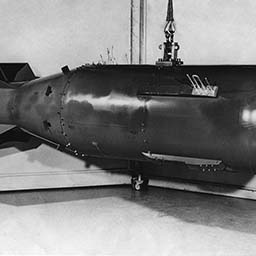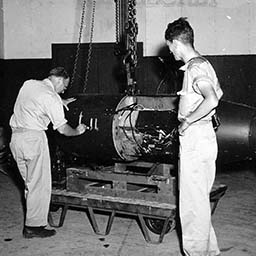Little Boy and Fat Man
In essence, the Little Boy design consisted of a gun that fired one mass of uranium 235 at another mass of uranium 235, thus creating a supercritical mass. A crucial requirement was that the pieces be brought together in a time shorter than the time between spontaneous fissions. Once the two pieces of uranium are brought together, the initiator introduces a burst of neutrons and the chain reaction begins, continuing until the energy released becomes so great that the bomb simply blows itself apart.
The initial design for the plutonium bomb was also based on using a simple gun design (known as the "Thin Man") like the uranium bomb. As the plutonium was produced in the nuclear reactors at Hanford, Washington, it was discovered that the plutonium was not as pure as the initial samples from Lawrence's Radiation Laboratory. The plutonium contained amounts of plutonium 240, an isotope with a rapid spontaneous fission rate. This necessitated that a different type of bomb be designed. A gun-type bomb would not be fast enough to work. Before the bomb could be assembled, a few stray neutrons would have been emitted from the spontaneous fissions, and these would start a premature chain reaction, leading to a great reduction in the energy released.
Seth Neddermeyer, a scientist at Los Alamos, developed the idea of using explosive charges to compress a sphere of plutonium very rapidly to a density sufficient to make it go critical and produce a nuclear explosion.





